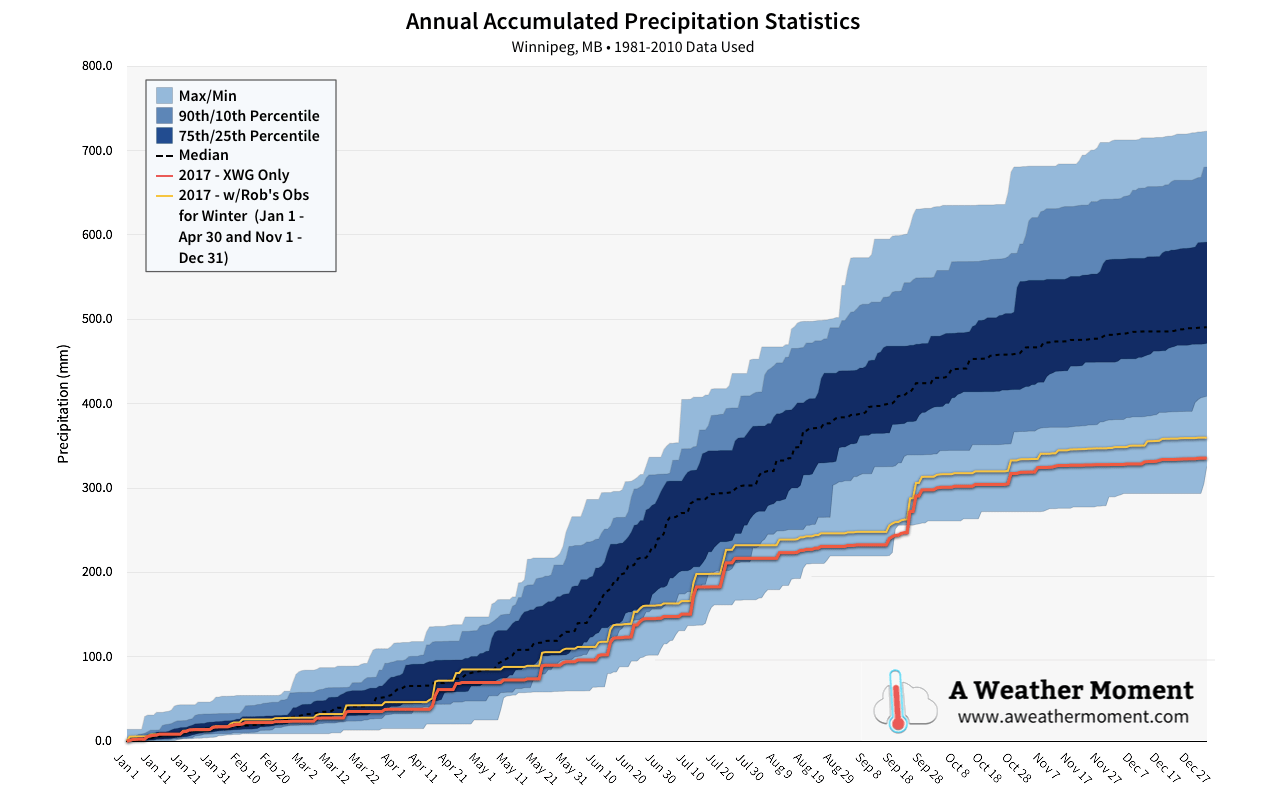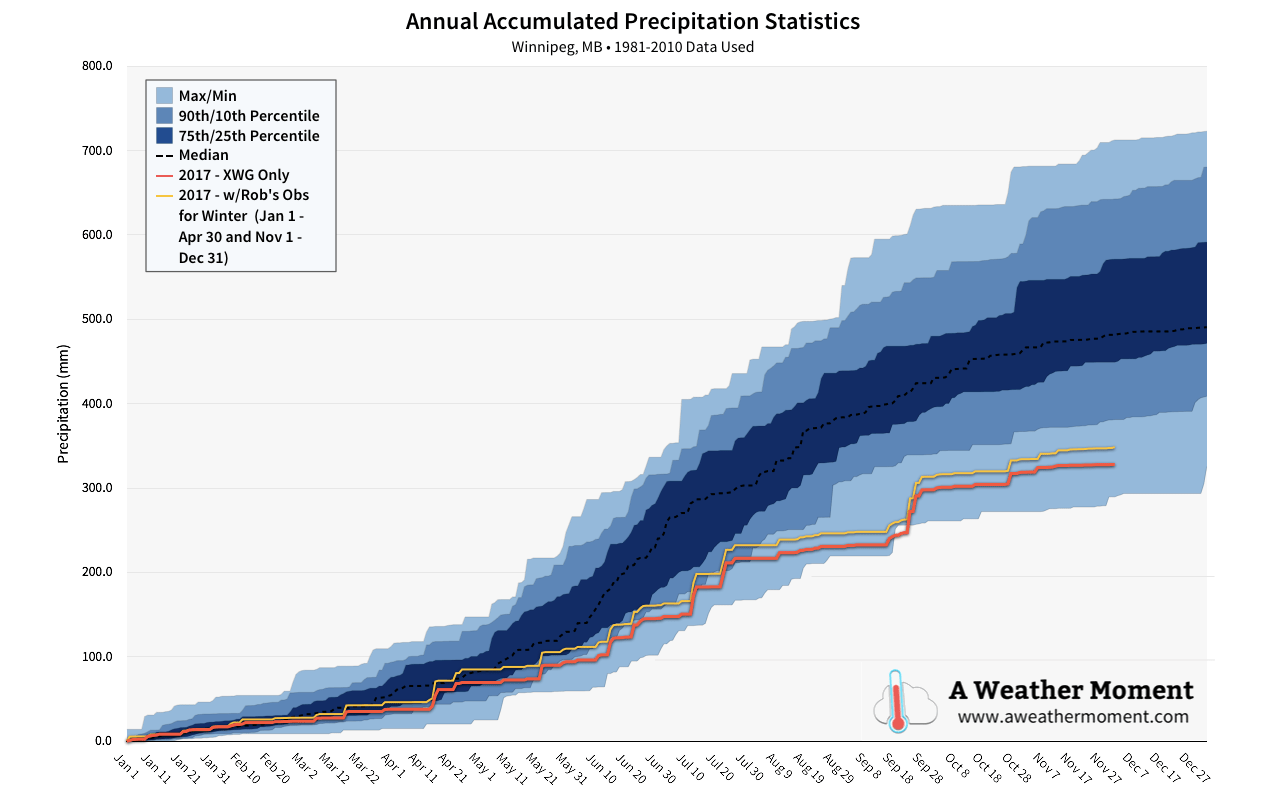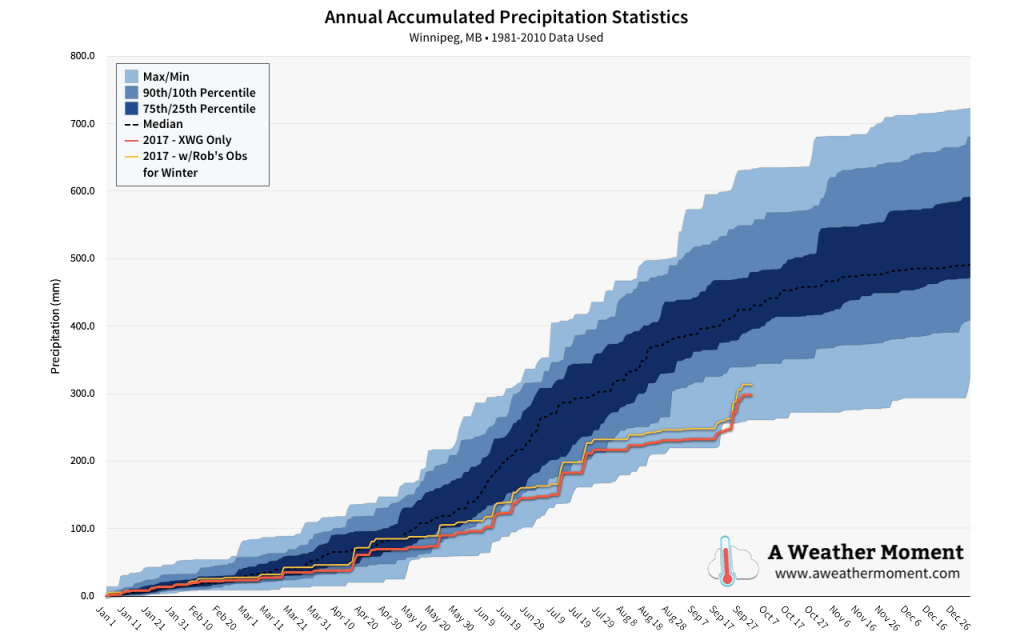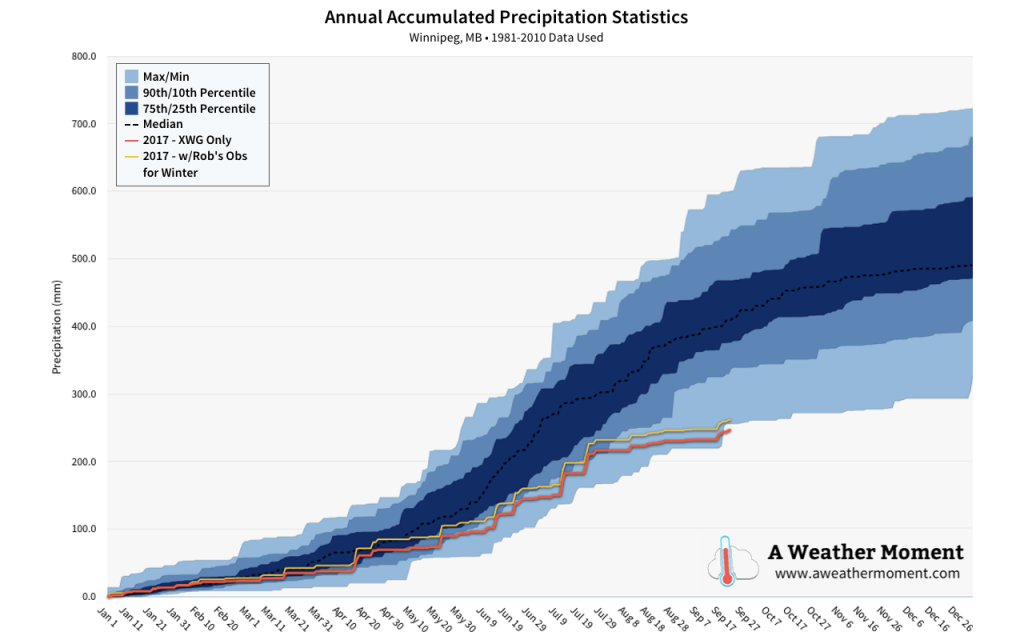November 2017’s mild end continued throughout the first two-thirds of December with daily mean temperatures as much as 13.8°C above normal. Things abruptly changed for the last third of the month, though, with daily mean temperatures plummeting to nearly 10°C below normal as daytime highs near 0°C were replaced by highs in lower minus 20’s and overnight lows as low as -35.5°C.
Although no records were set throughout December – the warmest weather was nowhere near warm enough and the cold weather couldn’t compare to the deep freeze of the late 1800s – the month was marked by gradually increasing warmth followed by an abrupt shift into significantly colder conditions just in time for Christmas. The high of -26.4°C on December 25th marked the 8th coldest high for Christmas Day in Winnipeg’s record. New Year’s Eve was also
The warmest day of the month occurred on December 18th when the temperature climbed to a high of +0.7°C, 11°C above the seasonal high of -10.3°C. With a daily minimum temperature of just -3.2°C, the day ended up with a mean temperature 13.8°C above seasonal at -1.3°C. The coldest day of the month came right near the end on December 30th; temperatures reached a high of just -27.9°C, colder than Christmas day and 15.7°C below the seasonal high for the day. The daily minimum temperature of -35.5°C was also the coldest measured for the month. They combined for a daily mean temperature of -31.7°C, the only day of the month with a sub-minus 30 mean temperature.
December had a monthly mean temperature of -14.8°C, which was 0.4°C below the seasonal normal of -14.4°C. The mean daily high temperature was -10.4°C, which was 0.7°C colder than normal. The mean daily low temperature was -19.2°C, just 0.1°C below normal. Warmer than normal daytime highs occurred on 17 of 31 days and warmer than normal overnight lows occurred on 17 of 31 days as well. 18 of 31 days saw warmer than normal daily mean temperatures, which just goes to show the relative intensity of the cold weather at the end of the month; despite only being in place for less than half the month, it was cold enough to bring the overall temperatures below seasonal averages. And despite Christmas ranking in the top 10 coldest, the month overall was unremarkable in the climatological standings: it ended as the 81st warmest December on record.1
The longest stretch of above-seasonal daily mean temperatures was 13, from December 7 to December 19. The longest stretch of below-seasonal days was 9, from December 23 to December 31.
The monthly temperature range was 38.0°C, from a maximum temperature of 2.5°C on December 2nd to a minimum temperature of -35.5°C on December 30th.
Rainfall Title
December 2017 brought Winnipeg’s rather dry 2017 to a close with more of the same. The airport climate observing site saw a paltry 7.5 mm of precipitation through the month, well below the climatological average of 20.6 mm.
The most significant precipitation event of the month occurred on the night of December 10th into the morning of December 11th when approximately 3-5 cm of snow fell, followed by some blowing snow. The airport received 2.8 mm of liquid equivalent from this event which was the single-largest event of the month. The second-largest precipitation event occurred on December 15/16, when light snow persisted for much of the two days. The airport received 2.1 mm of precipitation from this event. Lastly, the third notable precipitation event occurred on December 4th when freezing rain quickly gave way to snow for the remainder of the day. The city only received a couple of centimetres of snow with the airport reporting just 0.6 mm of liquid equivalent.
These three events combined to produce 73% of the month’s precipitation. The remainder was through numerous light to trace snowfall events. These events weren’t uncommon; there were another 9 days in December with measurable precipitation at the airport.

We’ll have more about the overall annual precipitation statistics in our 2017 climatological summary.
Forks Comparison
The urban heat island is a well documented weather phenomena, but we think it’s interesting to begin building a record of quantifying the variability of conditions between the middle of the city and the airport, both for interest’s sake as well as to better identify the difference in temperatures one may experience if they live closer to the core of the city versus nearer the perimeter.
As a general rule, we expect warmer conditions at the Forks, particularly at night, and no systematic difference in precipitation. The Forks is not considered the official climate record location for Winnipeg, so it will not be used for climatological rankings or comparisons.
Note: Due to technical problems, data for The Forks is unavailable for December 27th and 28th.
In December 2017, The Forks experienced higher daily mean temperatures on 28 of 29 days, warmer daytime highs on 22 of 29 days, and warmer overnight lows on 28 of 29 days. The monthly average high temperature was 0.5°C warmer at The Forks, the monthly average overnight low was 2.7°C warmer at The Forks, and the monthly mean temperature was 1.6°C warmer at The Forks.
The most noticeable temperature difference at The Forks occurred on December 19th where the Forks’ minimum temperature of -15.9°C was 6.8°C warmer than the airport’s -22.7°C.
The Forks ended the month with 0.9 mm more precipitation than the airport at 8.4 mm with all events within 1 mm of each other. This is still less than the Charleswood amounts by 2.8 mm, showing the shortcomings in utilizing automated systems to measure snowfall.
In the end, December was generally pleasant but had a bitterly cold finish. There were no major snowfall events and precipitation continued to be well below normal, rounding out a very dry year in Winnipeg.
Onwards to 2018!
- …or the 65th coldest, depending on how you’d like to look at it. ↩
- This is expected; in addition to not providing accurate snowfall accumulation measurements, the automated sensors used at the ECCC climate sites tend to under-report precipitation as the gauges can under-catch snowfall when there is wind. ↩
- For our purposes, a measure of trace snowfall is taken to equal 0.1 cm with 0.1mm of liquid equivalent. ↩



